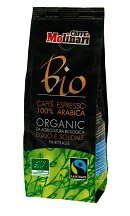Bioplastics started their development just recently, said Innovia’s Andy Sweetman at the Bio!Pac conference, last week. Fossil-based plastics are at the height of their learning curve, they cannot improve very much anymore. Whereas there is much room for improvement in the bioplastics area. Just 13 years ago, bioplastics only served for fruit wrapping; until 2 years ago, there were no biobased coffee capsules. Bioplastics are in rapid development.

Sweetman took the example of laminates. This is a sensitive subject. The majority of packaging materials consists of laminates: materials with several layers, like polyethylene, aluminium and paper, in order to attain all properties required: containment, barrier, appearance. Laminates are under attack by NGOs now, because recycling them is a nightmare. This month, they started a campaign against Kraft’s Capri Sun packaging; according to them, just 2% of these pouches have been collected in the US since their introduction in 1970, the rest having ended up as litter. But innovation does take place in this field; recently FrieslandCampina and Elopak announced the introduction of a new milk carton, produced solely from certified organic waste materials: the inside is polyethylene, the outside is paper. The partners call this ‘the most sustainable beverage carton ever’, with a strongly reduced carbon footprint. This is biobased packaging. But will it solve the recycling problem?
Bioplastics might be the alternative
In general, recycling is a problem precisely for the same reasons that the laminate was developed at all: the different properties of the respective layers. In principle, recycling can be done in one of two cycles: the technical cycle and the biological cycle. The technical cycle involves collecting and industrially processing discarded packaging. The only viable option for laminates would seem to be incineration: separation of the layers and processing the components separately is not an option. But it is precisely here that bioplastics might lead to alternatives.
Sweetman stressed that bioplastics producers would have to come up with a better quality (and a good price) in order to convince risk-avoiding industry to use their laminates. But according to him, this is not impossible. Biolaminates might use bioplastics like starch-based films, copolyesters or PBS films (to arrive soon) as the containment; barrier and appearance functions might be performed by bioplastics like cellulose acetate, regenerated cellulose or PLA. Together they could constitute a biodegradable laminate, provided that also inks and adhesives would be biodegradable. Innovative concepts already reduce the traditional three layers to two, resulting in lower costs. This could alter completely the waste management of laminates, as these new products could be disposed of in the green bin. With very good barrier properties and a good price, biolaminates would score in the end-of-life phase. The ‘only’ problem being that the consumer should know.

Rethink your packaging and your business model
This could be good news for Ecover (sold in the US under the name Method), the producer of biobased and sustainable household and personal care products. According to Ecover’s Tom Domen, the next speaker at the conference, the technical cycle does not work. Meaning: too much plastic from packaging ends up as litter. Ecover tries solutions like bottles produced from plastics, recovered from the ocean or from Amsterdam canals. But it keeps looking for alternatives. Like refill in the store, or making use of the biological cycle. Both options could require industry to rethink not only their packaging, but also their business model. For instance, in Ecover’s business: laminates from bioplastics perform better with solid than with liquid detergents. Whereas the public now prefers the liquid alternative. So, convince the customers that they should move over to solid?
Domen also argued that there is a political dimension to bioplastics. Industry might act quite differently if it were made responsible for the end-of-life phase of its products. Clearly, this is something that industry cannot achieve on its own; for this, it will need the will and the support of politics. But in the end, it might be beneficial to all. Industry should talk to politics about these issues, Domen concluded.
